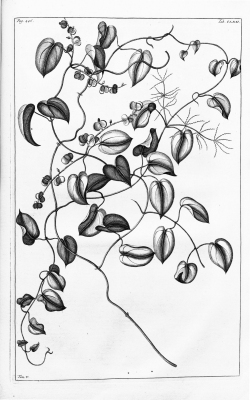Dioscorea nummularia
Lam.
Dioscoreaceae
Common Name:
General Information
Dioscorea nummularia is a perennial climbing plant producing annual, twining stems from a tuberous rootstock. These stems scramble over the ground, or twine into the surrounding vegetation[
].
The plant is widely cultivated in Indonesia, the Pacific Islands and Papua New Guinea for its edible root[
300- Title
- Vegetables in the Tropics
- Publication
-
- Author
- Tindall. H. D.
- Publisher
- MacMillan, Oxford.
- Year
- 1983
- ISBN
- 0-333-24268-8
- Description
- An excellent, in-depth look at the main vegetable crops that can be grown in the Tropics, plus many less well-known plants.
,
].
Known Hazards
Edible species of Dioscorea have opposite leaves whilst poisonous species have alternate leaves[
174- Title
- Atlas of Medicinal Plants.
- Publication
-
- Author
- Kariyone. T.
- Publisher
- Nihon Rinshosha; Osaka
- Year
- 1973
- ISBN
-
- Description
- A good Japanese herbal.
].
Botanical References
Range
Southeastern Asia - Indonesia, Pacific Islands, Papua New Guinea.
Habitat
Not known
Properties
| Edibility Rating |   |
| Other Uses Rating |   |
| Habit | Perennial Climber |
| Height | 0.00 m |
| Cultivation Status | Cultivated |
Cultivation Details
Plants grow best in lowland tropical areas with a temperature around 26 - 34°c; a well-defined dry season of 2 - 5 months; and a total rainfall of 1,300 - 1,700mm evenly distributed throughout the remainder of the year[
300- Title
- Vegetables in the Tropics
- Publication
-
- Author
- Tindall. H. D.
- Publisher
- MacMillan, Oxford.
- Year
- 1983
- ISBN
- 0-333-24268-8
- Description
- An excellent, in-depth look at the main vegetable crops that can be grown in the Tropics, plus many less well-known plants.
].
For best yields, this species requires a deep, well-drained, sandy loam that is not liable to water-logging[
300- Title
- Vegetables in the Tropics
- Publication
-
- Author
- Tindall. H. D.
- Publisher
- MacMillan, Oxford.
- Year
- 1983
- ISBN
- 0-333-24268-8
- Description
- An excellent, in-depth look at the main vegetable crops that can be grown in the Tropics, plus many less well-known plants.
].
Daylengths of more than 12 hours are preferred during the early growing season since this encourages vegetative growth; daylengths of less than 12 hours towards the end of the growing season will encourage tuber formation and development[
300- Title
- Vegetables in the Tropics
- Publication
-
- Author
- Tindall. H. D.
- Publisher
- MacMillan, Oxford.
- Year
- 1983
- ISBN
- 0-333-24268-8
- Description
- An excellent, in-depth look at the main vegetable crops that can be grown in the Tropics, plus many less well-known plants.
].
There are some named varieties[
300- Title
- Vegetables in the Tropics
- Publication
-
- Author
- Tindall. H. D.
- Publisher
- MacMillan, Oxford.
- Year
- 1983
- ISBN
- 0-333-24268-8
- Description
- An excellent, in-depth look at the main vegetable crops that can be grown in the Tropics, plus many less well-known plants.
].
The tubers form at an appreciable depth and are often left for 2 - 3 years to mature before harvesting[
300- Title
- Vegetables in the Tropics
- Publication
-
- Author
- Tindall. H. D.
- Publisher
- MacMillan, Oxford.
- Year
- 1983
- ISBN
- 0-333-24268-8
- Description
- An excellent, in-depth look at the main vegetable crops that can be grown in the Tropics, plus many less well-known plants.
].
A dioecious species, both male and female plants need to be grown if seed is required.
Edible Uses
Root - cooked[
300- Title
- Vegetables in the Tropics
- Publication
-
- Author
- Tindall. H. D.
- Publisher
- MacMillan, Oxford.
- Year
- 1983
- ISBN
- 0-333-24268-8
- Description
- An excellent, in-depth look at the main vegetable crops that can be grown in the Tropics, plus many less well-known plants.
,
]. The tubers of this species are never poisonous, but they are not generally preferred because of their saponin content[
].
Medicinal
None known
Other Uses
The tough stems are used for cordage[
].
Propagation
Seed - not normally used to propagate this species.
Cuttings of tubers. Small tubers can be cut into 2 - 4 sections, larger ones into 6 - 8 sections. Each section should have 2 - 3 dormant buds. The cut tuber is often left in the sun for several hours to promote wound healing and reduce the risk of fungal infection[
300- Title
- Vegetables in the Tropics
- Publication
-
- Author
- Tindall. H. D.
- Publisher
- MacMillan, Oxford.
- Year
- 1983
- ISBN
- 0-333-24268-8
- Description
- An excellent, in-depth look at the main vegetable crops that can be grown in the Tropics, plus many less well-known plants.
].
If you have any useful information about this plant, please leave a comment. Comments have to be approved before they are shown here.


 Useful Tropical Plants Database 2014 by
Ken Fern,
web interface by
Ajna Fern
with help from
Richard Morris.
Useful Tropical Plants Database 2014 by
Ken Fern,
web interface by
Ajna Fern
with help from
Richard Morris.